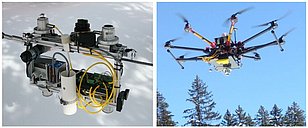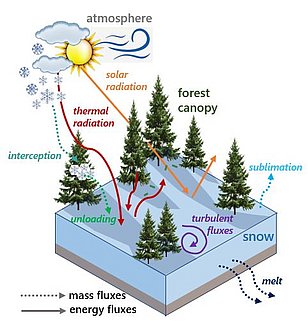Both snowfall distribution and snowmelt patterns are much more varied in forests than in open terrain. These variations are primarily controlled by the three-dimensional forest structure, where dense and sparse forest, gaps and edges create large differences in snow accumulation and melt patterns. To improve our predictions of snow cover progression in these areas, we need to better understand how forest structure controls how the snow falls and melts in forests.
Forests cover large portions of the northern hemisphere, including around 30% of Switzerland's surface area. Snowmelt from forests is therefore a huge contribution to freshwater supply. The presence of forests with snow further affects the reflectivity of the land surface. Dark trees absorb more solar energy than bright white snow, increasing energy absorption of the land surface and increased warming compared to open grasslands. Processes that control the snow cover evolution in forests therefore play a key role for both hydrology and climate.
Forest snow processes ¶
Forests intercept snowfall by holding the snow in the tops of the trees and reducing the amount that settles on the forest floor. During snowmelt, the forests absorb sunlight, which shades the snowpack from the solar radiation, but at the same time the forest is heated and emits thermal energy to the snow. The combination of these processes within highly diverse structures leads to very variable snow depths over short distances within forest, and creates radiation "hot" and "cold" spots very close together, causing large spatial differences in melt rate.
Monitoring and modelling snow in forests ¶
Most snowmelt models don’t feature these spatial differences in forest structure, mass and energy fluxes, leading to errors in snowmelt estimations that have consequences for downstream water usage. Current difficulties in modelling forest snow processes further contribute to the uncertainties of future climate projections. To improve these models, we have developed innovative remote sensing methods and ground-based technologies to measure the forest structure, snow distribution and solar and thermal radiation patterns inside and above forests. Our measurements are used in model development for hydrological applications such as the Operational Snow Hydrological Service as well as for climate modelling applications.
Topics ¶
Contact ¶
Links ¶
- EOS spotlight article on our thermal radiation measurements
- Our Sodankylä field campaign featured at the Finnish Meteorological Institute
- Measuring radiation transfer through the forest to improve our understanding of the snow albedo feedback
- Measuring the distribution of snow under forest with drone-based laser scanning


